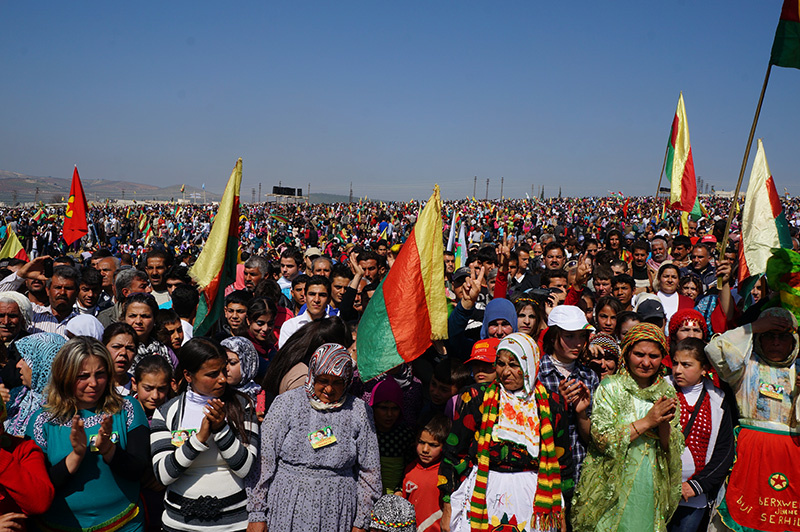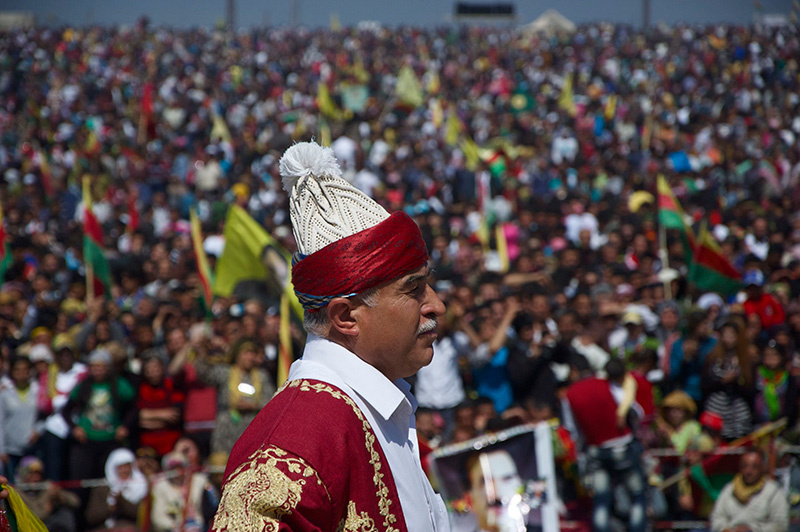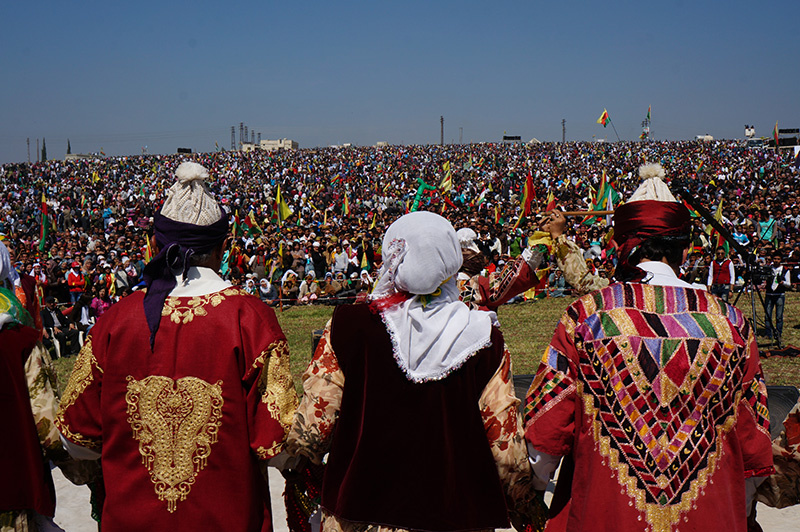(Photos by Martin Armstrong and Giacomo Cuscuna)When I first got to the large field overlooking the northern Syrian town of Afrin, I wasn’t quite ready for the scale of the celebration I had come to witness. Nawruz is the Ancient Persian New Year, the beginning of the Iranian calendar that is celebrated by the Kurdish diaspora as well as Persians and Zorastrians around the world on the vernal equinox. Afrin is only around 25 miles northwest of Aleppo, the rubble-strewn city at the center of Syria’s bloody civil war. But on March 21, the towns felt worlds apart.The sight of 50,000 people clad in the traditional Kurdish colors of red, yellow, and green greeted me that morning. Many held flags emblazoned with the image of imprisoned Turkish PKK leader Abdullah Ocalan. A few female Kurdish security guards stooped on rooftops, Kalashnikovs in hand. But Nawruz was a largely tension-free celebration, filled with traditional Kurdish dancing and accompanied by calls for the realization of Kurdish democratic rights within a “new Syria.” The celebration was stunning and eerie in contrast to the ongoing destruction and loss of life plaguing Aleppo and the more vitriolic atmosphere of the Nawruz festivities across the border in Diyarbakir, Turkey.“This is the start of a new year, and we hope a new era for Kurdish people within Syria,” exclaimed Ahmad Ali, 28, a local shopkeeper striking an optimistic tone. “This gathering is for the Kurdish people to show our unity and aspirations for freedom and democracy.”The sentiment was echoed by others within the crowd, the sheer scale of which would have been unimaginable in previous years when the Assad regime controlled the country and suppressed such gatherings. Since 1963, Syria’s Baath regime has often used heavy-handed and occasionally violent approaches when regulating Nawruz celebrations. In a community subject to a modern history of persecution that has intrinsically shaped their self-perception, the crowd's optimism was countered by a skepticism burnished by experience.“Nawruz is a symbol of freedom and resistance—and the struggle against forces of oppression,” stated Walid Bakr, 38, a member of West Kurdistan’s Teacher’s Union.“A gathering like this,” noted Bakr pointing to the crowd, “was impossible when the Assad regime controlled the country. Now we can celebrate freely. We do not want a separate Kurdish state, we want autonomy to govern ourselves and practice our culture within the Syrian state.”That same day, PKK leader Abdullah Ocalan called for a ceasefire to the PKK insurgency against the Turkish state. Festival goers expressed a palpable ambiguity regarding the relationship between the PKK and the YPG, the "popular protection units" of Kurds in Syria that maintain order and patrol Kurdish areas of the country. These armed militias of Kurds have controlled the area since May 2012 when YPG units alongside the Free Syrian Army defeated Assad’s forces the city of A'zaz eight miles east. Claims have circulated in the Western press and locally that some Kurdish groups are in league with the Assad regime. But people I spoke to rebuffed any such association.
Since 1963, Syria’s Baath regime has often used heavy-handed and occasionally violent approaches when regulating Nawruz celebrations. In a community subject to a modern history of persecution that has intrinsically shaped their self-perception, the crowd's optimism was countered by a skepticism burnished by experience.“Nawruz is a symbol of freedom and resistance—and the struggle against forces of oppression,” stated Walid Bakr, 38, a member of West Kurdistan’s Teacher’s Union.“A gathering like this,” noted Bakr pointing to the crowd, “was impossible when the Assad regime controlled the country. Now we can celebrate freely. We do not want a separate Kurdish state, we want autonomy to govern ourselves and practice our culture within the Syrian state.”That same day, PKK leader Abdullah Ocalan called for a ceasefire to the PKK insurgency against the Turkish state. Festival goers expressed a palpable ambiguity regarding the relationship between the PKK and the YPG, the "popular protection units" of Kurds in Syria that maintain order and patrol Kurdish areas of the country. These armed militias of Kurds have controlled the area since May 2012 when YPG units alongside the Free Syrian Army defeated Assad’s forces the city of A'zaz eight miles east. Claims have circulated in the Western press and locally that some Kurdish groups are in league with the Assad regime. But people I spoke to rebuffed any such association. “I hate Assad, and I also hate the Free Syrian Army,” stated Auri Van, a student in the final year of her baccalaureate studies. Van, a former resident of the Tal Ajjar district of Aleppo was forced to relocate to Afrin, two months ago as fighting between the FSA and Assad’s forces intensified near her home.“People here love Ocalan,” continued Van as chants in support of the imprisoned Kurdish resistance figure rang out amongst the crowd. “He is a leader for Kurdish people and the fight for the realization of our rights.”Sitting close to the front of the assembled crowd in the midday sun, Abdullah Shakarji, a historian specializing in the political and historical significance of Nawruz, expressed that the day’s proceedings also commemorated those who lost their lives in al-Qamishli soccer riots in March 2004, when local Kurdish fans clashed with an Arab team’s fans.
“I hate Assad, and I also hate the Free Syrian Army,” stated Auri Van, a student in the final year of her baccalaureate studies. Van, a former resident of the Tal Ajjar district of Aleppo was forced to relocate to Afrin, two months ago as fighting between the FSA and Assad’s forces intensified near her home.“People here love Ocalan,” continued Van as chants in support of the imprisoned Kurdish resistance figure rang out amongst the crowd. “He is a leader for Kurdish people and the fight for the realization of our rights.”Sitting close to the front of the assembled crowd in the midday sun, Abdullah Shakarji, a historian specializing in the political and historical significance of Nawruz, expressed that the day’s proceedings also commemorated those who lost their lives in al-Qamishli soccer riots in March 2004, when local Kurdish fans clashed with an Arab team’s fans. Shakarji linked the modern struggle of the Kurdish people in Syria and the wider Middle East to traditions of the past. The Shahnameh, a Persian epic poem from 1000 AD describes a frightful demon that plagued the Kurdish people. Zahhakan, an Assyrian necromancer with serpents sprouting from each of his shoulders ruled over Iran. Each day two young men were sacrificed to the serpents until a revolt led by a blacksmith named Kawa toppled the tyrant king.“Since the age of the Assyrians we have been struggling. Our struggle is not part of the Arab Spring. In the modern era Sykes-Picot divided our people in Syria, Turkey, Iraq, and Iran.“There is no difference between rulers today that oppress the Kurdish people and the Assyrian rulers. The same struggle goes on today.”More from Syria:The DefectorThe Little Lion: Syria's 11-Year-Old Killing MachineGround Zero: The Free Syrian Army
Shakarji linked the modern struggle of the Kurdish people in Syria and the wider Middle East to traditions of the past. The Shahnameh, a Persian epic poem from 1000 AD describes a frightful demon that plagued the Kurdish people. Zahhakan, an Assyrian necromancer with serpents sprouting from each of his shoulders ruled over Iran. Each day two young men were sacrificed to the serpents until a revolt led by a blacksmith named Kawa toppled the tyrant king.“Since the age of the Assyrians we have been struggling. Our struggle is not part of the Arab Spring. In the modern era Sykes-Picot divided our people in Syria, Turkey, Iraq, and Iran.“There is no difference between rulers today that oppress the Kurdish people and the Assyrian rulers. The same struggle goes on today.”More from Syria:The DefectorThe Little Lion: Syria's 11-Year-Old Killing MachineGround Zero: The Free Syrian Army
ΔΙΑΦΗΜΙΣΗ

ΔΙΑΦΗΜΙΣΗ

ΔΙΑΦΗΜΙΣΗ
